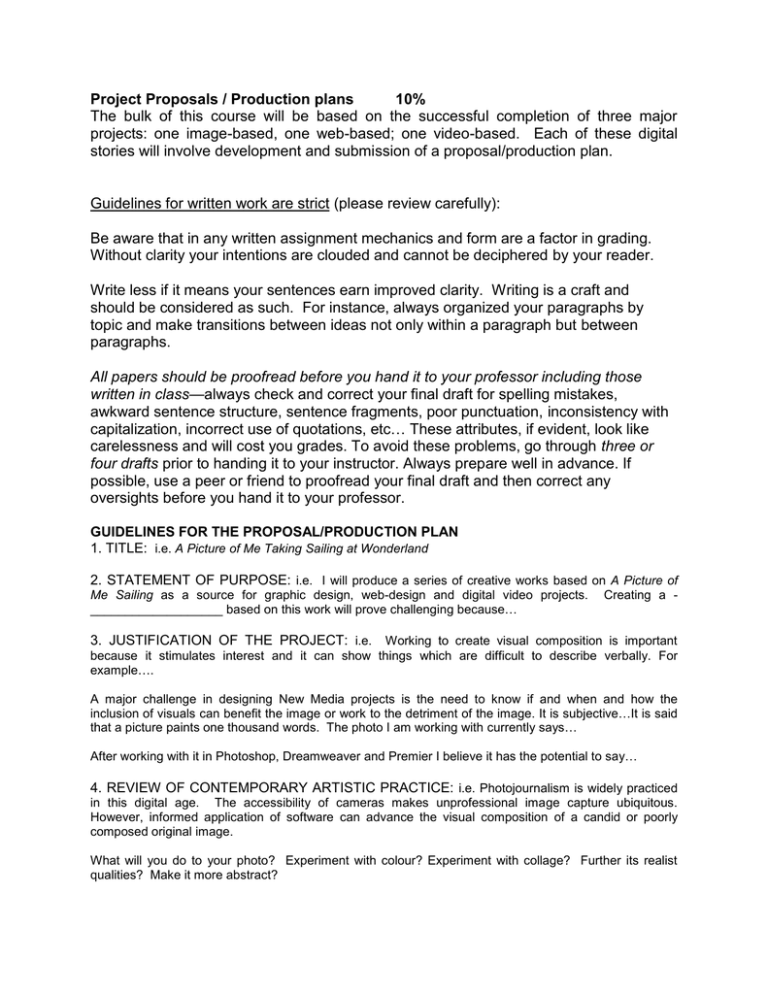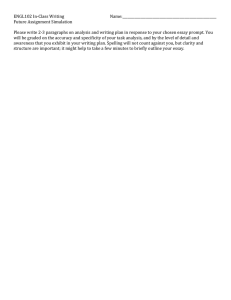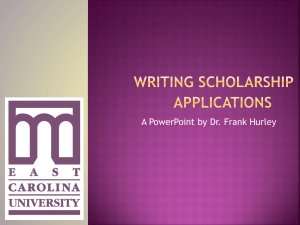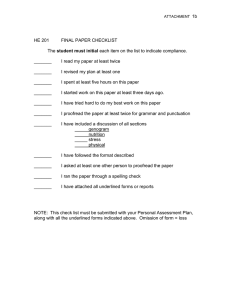Project Proposals / Production plans ... The bulk of this course ... projects: one image-based, one web-based; ...
advertisement

Project Proposals / Production plans 10% The bulk of this course will be based on the successful completion of three major projects: one image-based, one web-based; one video-based. Each of these digital stories will involve development and submission of a proposal/production plan. Guidelines for written work are strict (please review carefully): Be aware that in any written assignment mechanics and form are a factor in grading. Without clarity your intentions are clouded and cannot be deciphered by your reader. Write less if it means your sentences earn improved clarity. Writing is a craft and should be considered as such. For instance, always organized your paragraphs by topic and make transitions between ideas not only within a paragraph but between paragraphs. All papers should be proofread before you hand it to your professor including those written in class—always check and correct your final draft for spelling mistakes, awkward sentence structure, sentence fragments, poor punctuation, inconsistency with capitalization, incorrect use of quotations, etc… These attributes, if evident, look like carelessness and will cost you grades. To avoid these problems, go through three or four drafts prior to handing it to your instructor. Always prepare well in advance. If possible, use a peer or friend to proofread your final draft and then correct any oversights before you hand it to your professor. GUIDELINES FOR THE PROPOSAL/PRODUCTION PLAN 1. TITLE: i.e. A Picture of Me Taking Sailing at Wonderland 2. STATEMENT OF PURPOSE: i.e. I will produce a series of creative works based on A Picture of Me Sailing as a source for graphic design, web-design and digital video projects. ___________________ based on this work will prove challenging because… Creating a - 3. JUSTIFICATION OF THE PROJECT: i.e. Working to create visual composition is important because it stimulates interest and it can show things which are difficult to describe verbally. For example…. A major challenge in designing New Media projects is the need to know if and when and how the inclusion of visuals can benefit the image or work to the detriment of the image. It is subjective…It is said that a picture paints one thousand words. The photo I am working with currently says… After working with it in Photoshop, Dreamweaver and Premier I believe it has the potential to say… 4. REVIEW OF CONTEMPORARY ARTISTIC PRACTICE: i.e. Photojournalism is widely practiced in this digital age. The accessibility of cameras makes unprofessional image capture ubiquitous. However, informed application of software can advance the visual composition of a candid or poorly composed original image. What will you do to your photo? Experiment with colour? Experiment with collage? Further its realist qualities? Make it more abstract? 5. BACKGROUND OF YOUR CREATIVE VISION: i.e. Review your artist statement. 6. TREATMENT AND DESIGN OF THE PROJECT: i.e. These three digital projects will work together to communicate … 7. METHODS AND PROCEDURES: Here you outline exactly how you will proceed with the project. Specifically, research how you will access and collect additional visual and audio materials. 8. CONCLUSIONS AND DISCUSSIONS: What did you hope to learn through this creative process? How may it help you understand how to integrate your knowledge attitudes and abilities (competencies) to produce a digital work of art? Evaluated out of 40 points. 5 points for every section. 1 point for: Grammar, Spelling and Clarity; 2 points for: Demonstration of research of visual composition styles and methods. N.B.: Format footnotes where necessary; 2 points for: Review of Course Objective & Standards as presented in the course outline (See Section C of Course Outline) i.e. Integration of new media vocabulary presented in lectures. Due Week of October 1st. Section C : October 4th; Section D: October 3rd


